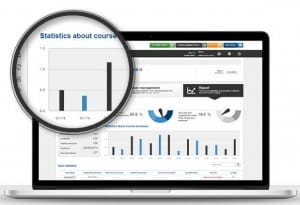Thanks to the flexibility of cloud technology and its integrated ecosystem, Docebo’s Learning Management System (LMS) is an effective solution to achieve Massive Open Online Courses.
Academic institutions, cultural foundations, non-profit organizations, and businesses are now involved in this new trend that is acheiving huge success, and is able to bring tangible results.
What is MOOC?
In 2012, a revolutionary new way of delivering E-Learning had arrived on the scene with the acronym MOOC. This technology consists of open, free access to a large number of online courses without any entry barriers.
The pioneers of this breakthrough methodology were large universities. The systems launched by these institutions have had immediate success, and were well received by the learning community.
Achievable results include:
- Large-scale circulation of culture within an organization
- Increase of brand awareness
- Gathering large amounts of data that can be used for analysis

Can these objectives be applied to cultural institutions, or even companies? The correct answer is yes. It should be pointed out that these objectives are required to be re-interpreted, and contextualized according to specific needs.
Adopting an initiative such as a MOOC is fundamental for the digital era. For example, MOOC’s can help enhance the preservation and study of archaeology, art, science, and technology. By preserving cultural knowledge and providing that knowledge online, via open source courses, cultural heritage can be maintained and disseminated rapidly and efficiently to an extensive audience of learners.
We can investigate companies that conduct research and create innovations in their fields of expertise. We can confirm that it is time to re-evaluate, and consider the impact; these include terms of costs and time, of in-person meetings, seminars, and open days. They can address sharing quality content on the web, and by leveraging cloud-based technologies, such as Learning Management Systems.
Why MOOC?
The choice must rely on the technology and methodologies that give assurance, and measurability on the results of learning. Uploading a video on YouTube is a great way to communicate and share content, but it won’t provide any measurable results, because it is not a suitable learning environment. It lacks the proper teaching strategy since there isn’t any control, verification, or monitoring.
We need to begin with an appropriate environment, designed with our objectives to disseminate content.
For over 10 years, E-Learning technology has been supporting the shift from instructor-led classes, to a virtual learning environment. Of course, we will have to imagine an open LMS that’s configured, and designed to accommodate MOOC.
 It’s important that the LMS comes with a system API. This will enable you to create content around a group of socially oriented services, as well as integrations. Through this, users can be involved in an open, and connected environment.
It’s important that the LMS comes with a system API. This will enable you to create content around a group of socially oriented services, as well as integrations. Through this, users can be involved in an open, and connected environment.
Users can login to their Facebook, or Twitter accounts, and participate in discussions, social activities, and even share their results on LinkedIn.
Learning Management Systems for a successful MOOC
In order to be successful, the MOOC initiatives should be characterized through an unambiguous and clear choice. The content should be presented in a univocal manner, where the environment is configurable by the instructors, the courses are managed, and the exams are standardized.
 These sets of standards can help companies, and institutions, make the right decision for a manageable MOOC initiative on a large scale. A Learning Management System, like Docebo, ensures that the design of the environment, hosting the content, has already been successfully tested. Therefore, a novice instructor can create their learning environment without complications.
These sets of standards can help companies, and institutions, make the right decision for a manageable MOOC initiative on a large scale. A Learning Management System, like Docebo, ensures that the design of the environment, hosting the content, has already been successfully tested. Therefore, a novice instructor can create their learning environment without complications.
Thanks to the reliability of learning technologies, organizations can now focus solely on instructional strategies applied to their curricula, and any related content.
Here are three key guidelines regarding this specific point:
- Choose a multimedia format that can be managed on a large scale: in other words, it must be time efficient, and cost-effective to be produced
- Users in these contexts are accustomed to short learning sessions
- Opt for brief and simple communication, so that users can easily adapt to the media without the support of a tutor
[banner-bottom-eng]
